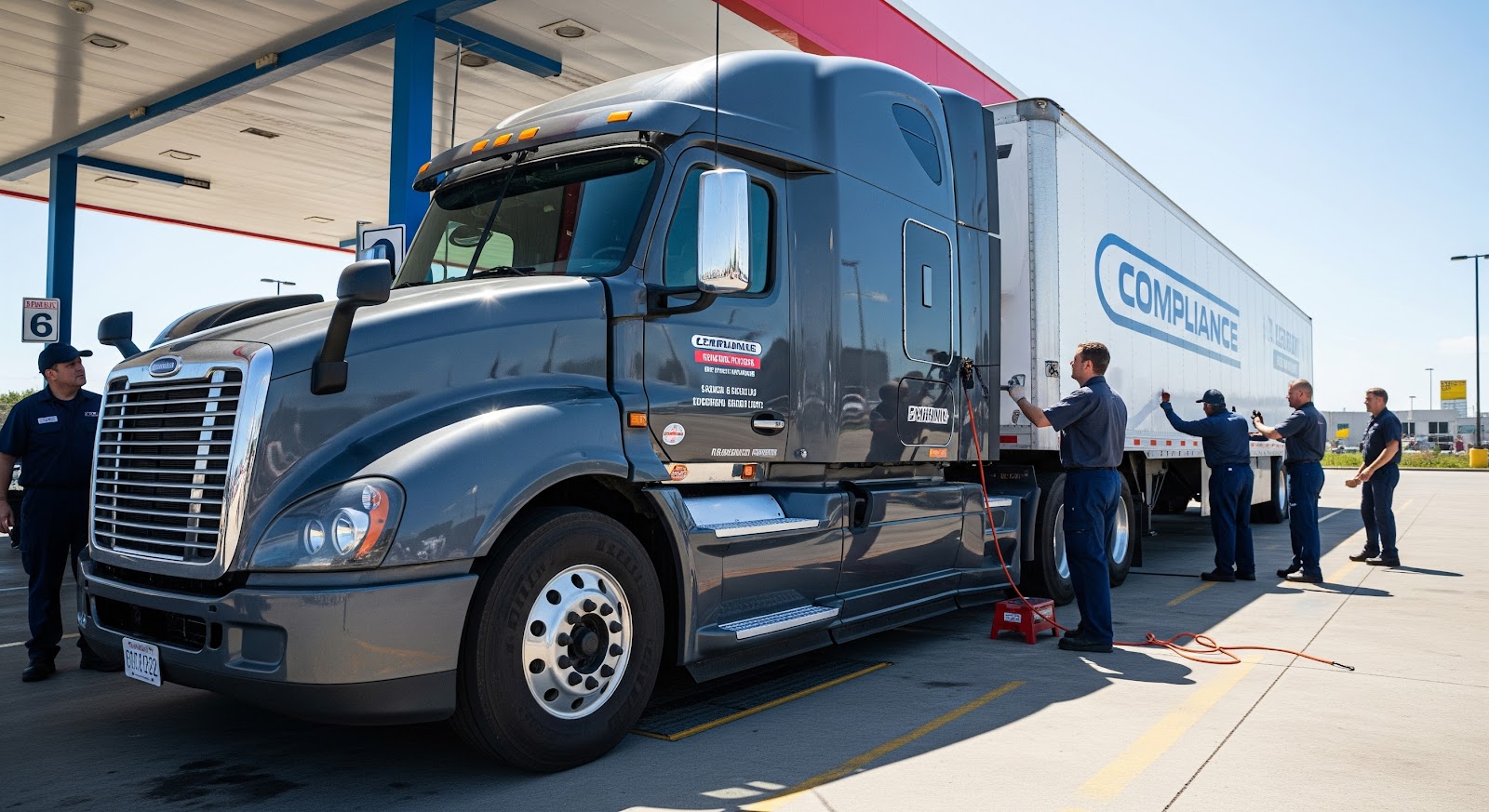The trucking industry serves as the backbone of the U.S. economy, transporting nearly 70% of the nation’s freight each year. To ensure the safety of drivers, the public, and the roadways, the Department of Transportation (DOT) plays a vital role in regulating commercial transportation, including trucking operations.
The DOT, through agencies like the Federal Motor Carrier Safety Administration (FMCSA), establishes and enforces standards that govern everything from vehicle maintenance and driver qualifications to hours of service and roadside inspections. These regulations are designed to reduce accidents, improve road safety, and maintain the integrity of the nation’s transportation system.
For trucking companies, staying updated on DOT regulations is not optional—it’s a legal requirement and a key factor in business success. Falling behind on regulatory changes can lead to costly penalties, vehicle downtime, failed inspections, or even the suspension of operating authority. With frequent updates to DOT laws for truck drivers, evolving safety standards, and technology-driven compliance tools like Electronic Logging Devices (ELDs), it’s critical that fleet managers, owner-operators, and drivers remain informed and proactive.
In this article, we’ll break down what DOT regulations are, explore the latest changes affecting the trucking industry, and explain how companies can stay compliant while keeping their operations running smoothly.
What Are DOT Regulations?
DOT regulations refer to the set of laws and guidelines established by the Department of Transportation to ensure the safety, efficiency, and reliability of the nation’s transportation system. These rules apply to various modes of transport, including aviation, rail, maritime, and—most critically for this discussion—the commercial trucking industry.
Definition and Purpose of DOT Regulations
In the context of trucking, DOT regulations are designed to:
- Promote road safety for both commercial drivers and the general public
- Reduce the risk of accidents caused by driver fatigue, vehicle malfunctions, or unsafe practices
- Establish uniform safety standards for commercial vehicles operating across state lines
- Hold trucking companies and drivers accountable for compliance and operational safety
These regulations cover a wide range of requirements, from driver qualifications and vehicle maintenance to hours of service limits and drug and alcohol testing.
How DOT Regulations Apply to Trucking Companies and Drivers
Whether you’re a fleet manager overseeing hundreds of vehicles or an independent owner-operator, DOT regulations for truck drivers directly affect your daily operations. Common requirements include:
- Maintaining a valid Commercial Driver’s License (CDL)
- Complying with Hours of Service restrictions to prevent fatigue
- Participating in mandatory drug and alcohol testing programs
- Keeping vehicles properly maintained and inspected
- Using approved Electronic Logging Devices for accurate tracking of driving hours
- Displaying a valid USDOT number for interstate operations
Failure to comply with DOT driving regulations can result in penalties, fines, vehicle out-of-service orders, or even loss of operating authority.
Agencies Involved in Enforcing DOT Regulations
Several federal and state agencies collaborate to enforce DOT laws for truck drivers, including:
- U.S. Department of Transportation: Oversees national transportation policies and safety standards.
- Federal Motor Carrier Safety Administration: The primary agency responsible for regulating commercial motor vehicles (CMVs) and enforcing safety rules for trucking companies and drivers.
- State DOT Offices: Implement and enforce federal regulations within their jurisdictions, often adding state-specific requirements.
- State Police and Highway Patrol: Conduct roadside inspections, weigh station checks, and enforce compliance with safety laws.
Together, these agencies work to uphold the integrity of the commercial trucking industry, ensuring that all operators meet safety and legal requirements.
Key DOT Regulations for Truck Drivers
The DOT regulations for truck drivers are designed to promote safety, prevent accidents, and ensure that all commercial motor vehicle (CMV) operators meet strict standards. Whether you’re an independent driver or part of a large fleet, understanding these core regulations is essential for staying compliant and avoiding costly violations.
Hours of Service (HOS) Rules
One of the most critical components of DOT driving regulations is the Hours of Service rules, which aim to prevent driver fatigue — a leading cause of truck-related accidents. The Federal Motor Carrier Safety Administration enforces these rules, which include:
- 11-Hour Driving Limit: Drivers may drive a maximum of 11 hours after 10 consecutive hours off duty.
- 14-Hour Window: Drivers cannot drive beyond the 14th consecutive hour after coming on duty, following 10 consecutive hours off duty.
- 30-Minute Break Requirement: Drivers must take a 30-minute break after 8 cumulative hours of driving.
- 60/70-Hour Limit: Drivers cannot exceed 60 hours on duty over 7 consecutive days or 70 hours over 8 consecutive days, depending on the company’s operations.
- Sleeper Berth Provision: Drivers can split their required 10-hour off-duty time, provided certain conditions are met.
HOS rules are monitored using Electronic Logging Devices (ELDs), which are mandatory for most CMV operators.
Drug and Alcohol Testing Requirements
Another critical area of DOT regulations for truck drivers is the mandatory Drug and Alcohol Testing Program, which helps ensure that drivers operate vehicles free from the influence of substances that could impair their ability to drive safely.
The DOT requires testing in several circumstances:
- Pre-employment testing before a driver can operate a CMV
- Random testing throughout the year
- Post-accident testing in certain situations
- Reasonable suspicion testing based on observable behavior
- Return-to-duty and follow-up testing for drivers who previously tested positive
Failing or refusing a drug or alcohol test results in immediate removal from safety-sensitive duties and possible suspension of driving privileges.
Commercial Driver’s License Standards
Holding a valid Commercial Driver’s License is a fundamental requirement for operating a CMV over 26,001 lbs, vehicles transporting hazardous materials, or passenger vehicles designed to carry 16 or more people. DOT regulations specify:
- Age requirements (generally 21+ for interstate operations)
- Written knowledge and skills tests
- Endorsements for specialized operations, such as hazardous materials (HazMat) or double/triple trailers
- Regular medical certification to confirm a driver’s physical ability to safely operate a CMV
Failure to maintain a valid CDL or operating beyond license restrictions can lead to severe penalties for both drivers and their employers.
Vehicle Maintenance and Inspection Guidelines
Proper vehicle maintenance is essential for preventing mechanical failures that could lead to accidents. Under DOT laws for truck drivers, companies and drivers must:
- Perform regular inspections of their vehicles, including pre-trip, en-route, and post-trip checks
- Maintain accurate records of repairs, maintenance, and inspections
- Ensure that all parts and accessories, such as brakes, tires, lights, and steering mechanisms, are in proper working order
- Comply with annual inspection requirements as mandated by FMCSA regulations
DOT roadside inspections can occur at weigh stations or during random stops, and vehicles found in violation may be placed out of service until corrections are made.
Collectively, these DOT regulations for truck drivers play a vital role in promoting safe, legal, and efficient trucking operations. Compliance not only protects drivers but also safeguards the reputation and bottom line of trucking companies.
DOT Laws for Truck Drivers: Common Violations to Avoid
Understanding and adhering to DOT laws for truck drivers is crucial not only for staying compliant but also for ensuring the safety of everyone on the road. Unfortunately, many trucking companies and drivers face penalties due to avoidable violations. Here are some of the most common compliance issues—and how they can harm your business.
Hours of Service Violations
Failing to follow Hours of Service rules is one of the most frequent—and heavily penalized—violations under DOT regulations for truck drivers. Examples include:
- Exceeding the maximum daily driving limits
- Failing to take required rest breaks
- Driving beyond the allowable 14-hour work window
- Ignoring weekly cumulative driving hour restrictions
HOS violations are typically discovered during roadside inspections, weigh station checks, or through Electronic Logging Device (ELD) records. Repeated violations can trigger DOT audits, lead to costly fines, and even jeopardize a driver’s or company’s operating authority.
Logbook Inaccuracies
Accurate and honest recordkeeping is essential for demonstrating compliance with DOT driving regulations. Logbook violations often involve:
- Falsified driving records
- Incomplete or missing log entries
- Failing to use an approved ELD device
- Incorrectly documenting hours or duty status
Logbook inaccuracies are considered serious violations, as they often indicate attempts to hide HOS infractions. During inspections, officers will closely scrutinize logbooks, and discrepancies can result in immediate fines and out-of-service orders.
Vehicle Safety Infractions
Vehicle maintenance is a key part of DOT laws for truck drivers, yet safety violations are still common, including:
- Faulty brakes, worn tires, or defective lights
- Inoperative turn signals or windshield wipers
- Loose or damaged cargo securement equipment
- Failure to perform required pre-trip inspections
Vehicles that fail roadside safety checks may be placed out of service until repairs are completed, causing delivery delays and lost revenue. Poor vehicle maintenance also increases accident risk, which can severely damage a company’s reputation and legal standing.
Driving Without Proper Documentation
Truck drivers are required to carry specific documents at all times to comply with DOT regulations, including:
- Valid Commercial Driver’s License
- Medical Examiner’s Certificate
- Proof of insurance
- Vehicle registration and inspection reports
- IRS-stamped Schedule 1 for Heavy Vehicle Use Tax (HVUT) compliance
Operating without the proper documentation can lead to fines, impoundment of the vehicle, or being barred from transporting loads—disrupting operations and harming client relationships.
How Violations Impact Safety Scores and Reputation
Every violation affects a company’s Compliance, Safety, Accountability (CSA) Score, which is used by the FMCSA to assess safety performance. High CSA scores can result in:
- Increased roadside inspections
- Loss of business partnerships
- Insurance rate hikes
- Potential FMCSA investigations or audits
- Suspension of operating authority for severe or repeat violations
Maintaining compliance with DOT laws for truck drivers is not just about avoiding fines—it’s about protecting your business, ensuring road safety, and building a trustworthy reputation in the trucking industry.
Best Practices for Trucking Companies to Stay Compliant
Compliance with DOT regulations is not a one-time task—it’s an ongoing responsibility that directly affects your company’s safety record, operational efficiency, and bottom line. By implementing these best practices, trucking companies can reduce the risk of violations, protect their CSA scores, and ensure they meet all federal and state regulatory requirements.
Regular Training and Education for Drivers
Your drivers are on the front lines of your operation, which means they need to be fully informed about DOT laws for truck drivers. Providing consistent training helps:
- Ensure drivers understand Hours of Service rules
- Keep them up to date on new DOT driving regulations
- Teach proper vehicle inspection procedures
- Reinforce drug and alcohol testing policies
- Promote safe driving habits and defensive driving techniques
Training should be ongoing, with refresher courses provided annually or whenever significant regulatory changes occur. Well-trained drivers are more likely to pass inspections and avoid costly compliance mistakes.
Investing in Compliance Management Tools
Managing compliance manually is time-consuming and prone to errors. Investing in modern compliance management tools streamlines processes and reduces risk. Essential tools include:
- Electronic Logging Devices (ELDs) for HOS tracking
- Automated vehicle inspection apps
- Document management systems for storing driver qualifications, medical certificates, and other required paperwork
- Compliance dashboards to monitor violations, maintenance schedules, and training records
These tools not only simplify recordkeeping but also provide real-time insights, allowing fleet managers to proactively address potential compliance issues before they escalate.
Using Fleet Technology for Tracking and Reporting
Fleet technology has revolutionized the way trucking companies maintain compliance with DOT regulations. GPS tracking, telematics, and integrated reporting systems offer:
- Real-time monitoring of vehicle locations and driver behavior
- Alerts for maintenance needs or unsafe driving patterns
- Automated reporting for HOS, vehicle inspections, and fuel usage
- Improved route planning to reduce operational delays
With fleet management technology, companies can stay ahead of compliance requirements, enhance safety, and improve operational efficiency—all while minimizing the risk of violations.



